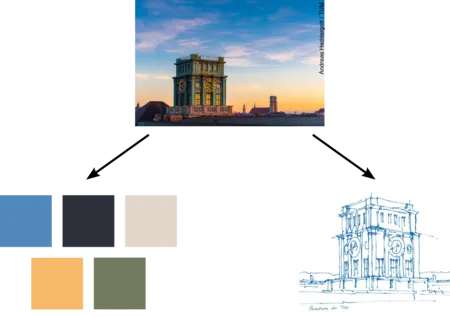Model Order Reduction for Vibro-acoustic Problems
Vibroacoustic simulations are used to assess the vibration behavior and sound radiation of structures. To capture the characteristic wave phenomena and the coupling between structure and acoustic fluid properly, a fine discretization of the numerical models has to be chosen. This results in very large systems of equations, which cannot be handled efficiently and are very computationally expensive to solve. The model order reduction (MOR) provides powerful tools to reduce the size of the numerical models while the system response of the reduced system does not change significantly.
Interpolatory MOR methods reduce the original model by finding a matrix projecting the full system on a much smaller subspace, which contains the desired solution. Finding a suitable projection or reduction basis and its efficient computation is the key to a properly reduced model. This is illustrated in the figure below. Here, two ways of reducing the complex image of the TUM bell tower are shown. Both lead to a simpler representation and are similarly elaborate to obtain, but only the sketch contains the information necessary for us to recognize the bell tower. So the method “sketching” can be seen as a suitable reduction basis.

Besides standard MOR methods, there exist frameworks to generate models depending on sets of parameters. These models can be evaluated for different values of the parameters in reduced space and are therefore very efficient for parameter studies. This is often relevant for vibro-acoustic problems, as for example a proper size for a noise-absorber has to be found iteratively. These methods are known by the keyword “parametric MOR” or PMOR.
Reduced models for vibroacoustic problems can be used in many application fields like the design of acoustic metamaterials, sound propagation through structures such as airplanes and trains, or room and building acoustics, among others. Parametrically reduced models can be used for the efficient optimization of sound radiating structures.
Theses and study projects
Further reading
- A. C. Antoulas, Approximation of large-scale dynamical systems. Philadelphia: SIAM, 2005.
- P. Benner, S. Gugercin, and K. Willcox, “A Survey of Projection-Based Model Reduction Methods for Parametric Dynamical Systems,” SIAM Rev., vol. 57, no. 4, pp. 483–531, 2015.
- A. van de Walle, “The Power of Model Order Reduction in Vibroacoustics and its Applications in Model-based Sensing,” PhD Thesis, Leuven, 2018. Available online at: https://lirias.kuleuven.be/1748823?limo=0
Contact
Raul Rodriguez
Quirin Aumann